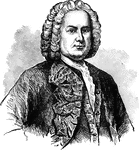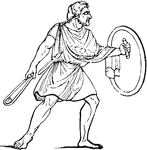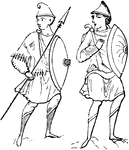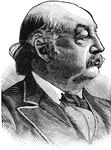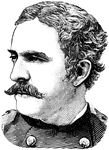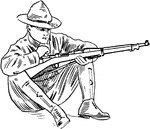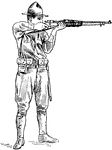
Roman Clypeus
"The following cut represents a Roman clypeus, from the column of Trajan. The projection in the centre…

Greek soldier
"The early Greeks used a very short sword, as may be seen from the preceding cut. The ancient Homeric…
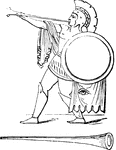
Roman trumpet
"There appears to have been no essential difference in form between Greek and Roman or Tyrrhenian trumpets.…
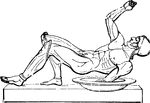
Fallen soldier
"Figure of a fallen warrior, represented among the sculptures now at Munich, belonging to the temple…
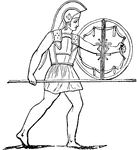
Greek with shield
"In the Homeric times, the Greeks used a belt for the sword, and another for the shield. These passed…

Halt
"Carry the hand to the shoulder; rapidly thrust the hand upward the full extent of the arm several times."…

Change Direction Signal
"The hand on the side toward which the change of direction is to be made is carried across the body…

As Skirmishers, Guide Center, March Signal
"Raise both arms laterally until horizontal; swing both simultaneously upward until vertical and return…

As Skirmishers, Guide Right (Left), March Signal
"Raise both arms laterally until horizontal; hold the arm on the side of the guide steadily in the horizontal…
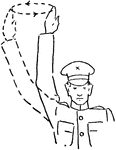
Assemble, March
"Raise the arm vertically to its full extent and describe horizontal circles." — Moss, 1914

Range or Change Elevation
"To announce range, extend the arm towar the leaders or men for whom the signal is intended, fist closed;…

Suspend Firing
"Raise and hold the forearm steadily in a horizontal position in front of the forehead, palm of the…
Parade Rest
"Carry the right foot 6 inches straight to the rear, left knee slightly bent; clasp the hands, without…
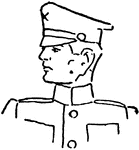
Eyes right
At the command right, turn the head to the right oblique, eyes fixed on the line of eyes of the men…

Salute
"Raise the right hand smartly till the tip of the forefinger touches the lower part of the headdress…

Soldier with Rifle
"In resuming the order from any position in the manual, the motion next to the last concludes with the…
Order Arms Standing
"The butt rests evenly on the ground, barrel to the rear, toe of the butt on a line with toe of, and…
Present Arms
"With the right hand carry the piece in front of the center of the body, barrel to the rear and vertical,…
Port Arms
"With the right hand raise and throw the piece diagonally across the body, grasp it smartly with both…
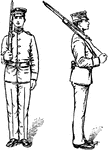
Right Shoulder, Arms
"Without changing the grasp of the right hand, place the piece on the right shoulder, barrel up and…
Parade Rest with Rifle
"Carry the right foot 6 inches straight to the rear, left knee slightly bent; carry the muzzle in front…
Trail Arms
"Raise the piece, right arm slightly bent, and incline the muzzle forward so that the barrel makes an…
Rifle Salute
"Carry the left hand smartly to the small of the stock, forearm horizontal, palm of hand down, thumb…
Rifle Salute
"Carry the left hand smartly to the right side, palm of the hand down, thumb and fingers extended and…
Inspection Arms
"At the second command take the position of arms. Seize the bolt handle with the thumb and forefinger…
Stack Arms
"Each even number of the front rank grasps his piece with the left hand at the upper band and rests…

Stack Arms
"Throws the butt about 2 feet in advance of that of his own piece and opposite the right of the interval,…
Stack Arms
"Each odd number of the front rank raises his piece with the right hand, carries it well forward, barrel…

Stack Arms
"He then turns the barrel outward into the angle formed by the other two pieces and lowers the butt…

Take Aarms
"Each even number of the front rank diengages and detaches his piece by turning it to the left." —…

Kneel
"Kneel on right knee, sitting as nearly as possible on the right heel; left forearm across left thigh;…
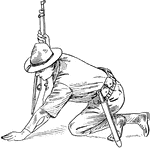
Lie Down
"Carry back the left foot and lie flat on the belly, inclining the body about 35 degree to the right."…

Lie Down
"Carry back the left foot and lie flat on the belly, inclining the body about 35 degree to the right."…
Load
"At the command load each front-rank man or skirmisher faces half right and carries the right foot to…

Load
"Each rear rank moves to the right foot, takes a similar position opposite the interval to the right…
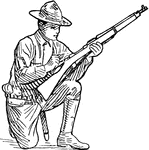
Kneeling
"If kneeling or sitting, the position of the piece is similar; if kneeling, the left forearm rests on…
Lying Down
"If lying down, the left hand steadies and supports the piece at the balance, the toe of the butt resting…
Aim
"Left eye closed, right eye looking through the notch of the rear sight so as to perceive the object…






